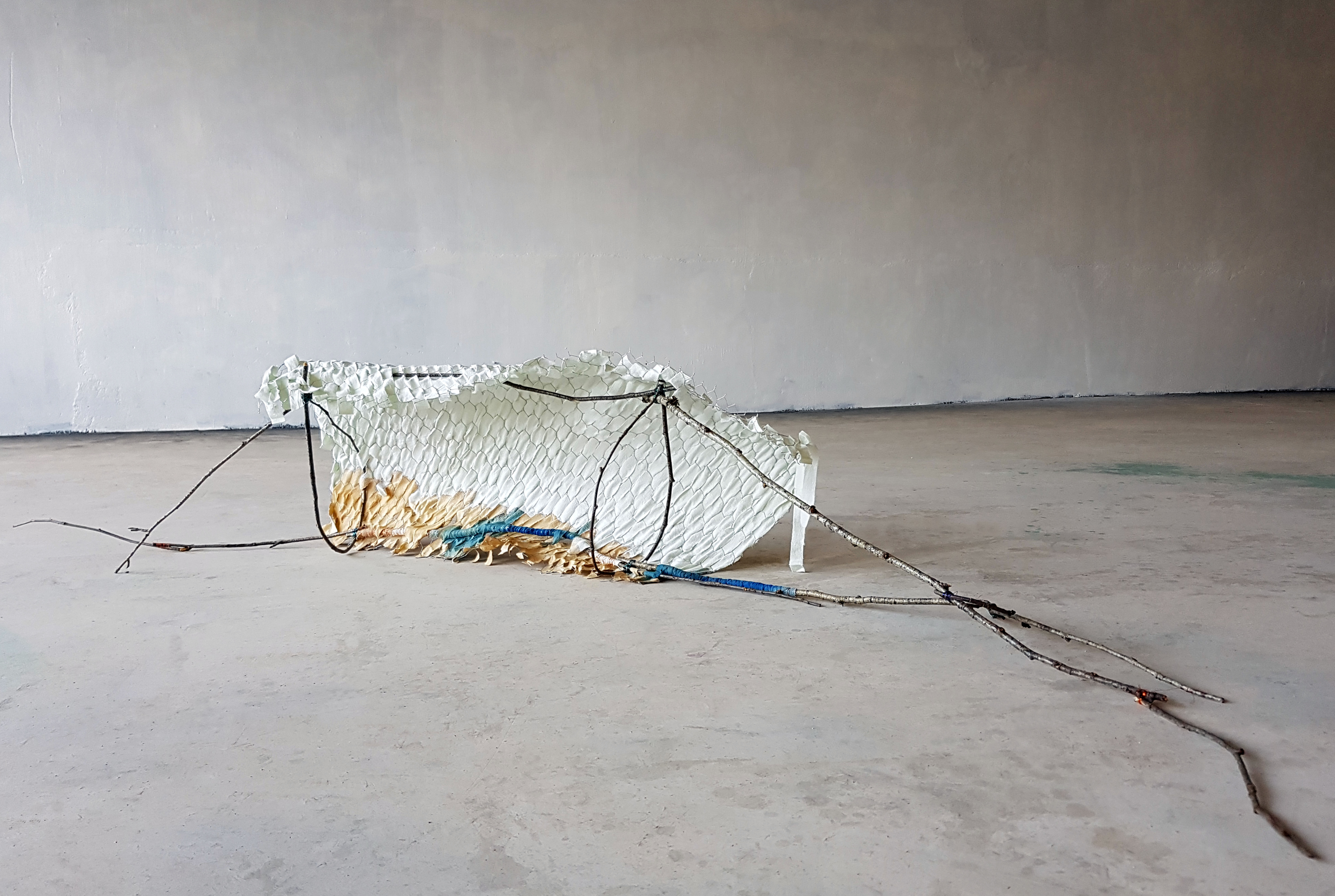Familiar
Surnadal Billag
September, 2020
1. You as shelter, me as shelter # I
2. You as shelter, me as shelter # I
3. You as shelter, me as shelter # II
4. Familiar
5-6. You as shelter, me as shelter # III
7-8. You as shelter, me as shelter # IV
The series of sculptures, each
individually titled You as shelter, me as
shelter (2020) was created during a residency at Surnadal Billag. The small
village of Surnadal is located along the mid-western coast of Norway, and is
surrounded by mountains, forests, lakes, rivers, and waterfalls. This is a notable
contrast to the industrial and urban environments, and their resultant materials,
that the artist usually encounters traveling to and from his studio in the
city of Bergen. In keeping with his methodology, Løland took very little with him to the
residency, preferring to gather materials locally for the creation of his work.
Due to his surroundings, these salvaged objects contained more organic
and less industrial materials than usual. Thus sticks, leaves, and bark featured in many of
these distinctive works.
Surnadal Billag
September, 2020
1. You as shelter, me as shelter # I
2. You as shelter, me as shelter # I
3. You as shelter, me as shelter # II
4. Familiar
5-6. You as shelter, me as shelter # III
7-8. You as shelter, me as shelter # IV
The series of sculptures, each
individually titled You as shelter, me as
shelter (2020) was created during a residency at Surnadal Billag. The small
village of Surnadal is located along the mid-western coast of Norway, and is
surrounded by mountains, forests, lakes, rivers, and waterfalls. This is a notable
contrast to the industrial and urban environments, and their resultant materials,
that the artist usually encounters traveling to and from his studio in the
city of Bergen. In keeping with his methodology, Løland took very little with him to the
residency, preferring to gather materials locally for the creation of his work.
Due to his surroundings, these salvaged objects contained more organic
and less industrial materials than usual. Thus sticks, leaves, and bark featured in many of
these distinctive works.
In some ways, all of Løland’s work reflects the places in
which they are made. However, the sculptures created in Surnadal feel truly
site-specific as they were crafted on site rather than in a studio or gallery
setting. They incorporate not only his previous conceptual leanings, but also take
into account the relationship of architecture between the setting and the human
body. Despite its idyllic surroundings, the residency itself was housed inside
of a large, empty bus station. The building was intimidatingly cavernous,
echoing and anonymous. Løland responded to the visceral feeling of the space by
creating shapes inspired by the Norwegian “gapahuk”, or lean-to; simple constructions
hastily built to serve as temporary shelters in the wild.
Løland wanted to add a body-based shape to the architecture
as a counter to the barren, inhuman space. These constructions are architectures
built around imagined bodies, and are inseparable from the bodies that they
would shelter. In this, these structures are reminiscent not only of the
manmade gapahuk, but also animal dens, insect cocoons, bird nests, and other
structures in nature quotidian to specific species. This is the original architecture,
a shelter that is formed by and morphs along with the bodies of living animals.
It is a refreshing reminder that humans too are animals in our most basic
nature, both in need of and capable of building shelters for ourselves. Familiar reanimates buildings, remembers
them as living entities inseparable from those bodies that they were created to
house.
These sculptures feel alive in and of themselves, apart from
the hands that made them. The branches, woven chicken wire, and netting form
limbs and skins and read as mythical animals come to life. The figures placed
about the room walk, perch, and recline on the ground, both eerie and
nonthreatening. The title of the collection in its entirety, Familiar, is on the nose. As in the vast
majority of Løland’s artworks, these objects are vaguely recognizable,
comforting and yet strange. They are alluring and invite interaction beyond
mere observation. Yet there is another meaning here. In English, the word
“familiar” connotes that which is well known, something or someone that has
been encountered previously. However, in Norwegian, the word “familiar” signifies
a close familial relationship or family structure. Once again, these
constructions come alive. The sculptures could be seen as a family unit of
built structures, returning the built environment back into the purview of the
living.
In alignment with the idea of the gapahuk, all the artworks
created during the residency were dismantled at the end of the residency and
the materials returned to nature (where appropriate), much as a gapahuk would
be taken apart and scattered as the hiker continues his or her journey. Most of
Løland’s work is in some state of evolutionary flux. However, the decisive
beginning and end of the Familiar project
reads as a self-contained exercise within Løland’s larger practice.
By Heather Jones







